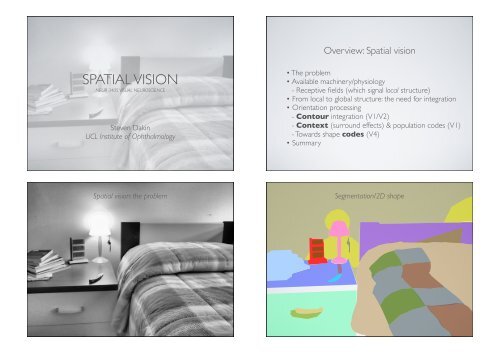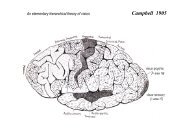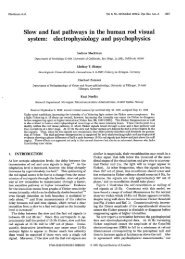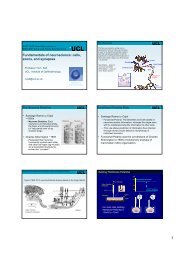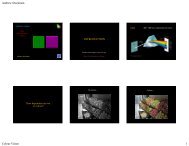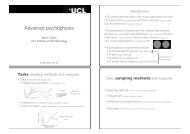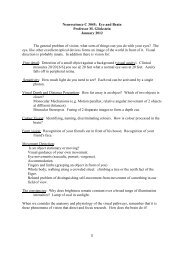Spatial Vision
Spatial Vision
Spatial Vision
You also want an ePaper? Increase the reach of your titles
YUMPU automatically turns print PDFs into web optimized ePapers that Google loves.
Making local orientation explicit (V1)Machinery• Retina• LGN• V1• V2• V4• ITSensitivity• Luminance/contrast• Luminance/contrast (SF)• Contrast (SF/orientation)• Orientation/contour• Contour/2D shape• 2D shape/3D shapeLocal versus globalprocessingThe need to integrate• Integration (“binding”)• Gain control(segmentation)• Disambiguates local information• Global information can bemore informative (e.g. shape)
Contour integration: A psychophysical paradigmCase study: Contour integration
Contour integration: A psychophysical paradigmContour integration: A psychophysical paradigmHow are local signals integrated?How are local signals integrated?• Stimulus: targets local receptive fields....• Stimulus: targets local receptive fields....... and then removes “clues” from densityThe “Rules of Association” I: OrientationThe “Rules of Association” I: Orientation• Harder with morecurved contours• Harder with localperpendicularorientation• Harder with morecurved contours• Harder with localperpendicularorientation
The “Rules of Association” II: <strong>Spatial</strong> frequency ✔Association field for contour integrationFacilitatoryInhibitoryMotion ✔ Contrast ✖ Closure ✖• Candidate mechanisms: Long range horizontal connections (Gilbert et al,1989) or feedback (e.g. from V2)• Anatomy (Angelucci & Bresloff, 2006) favours feedbackAssociation field for contour integration• Matched to statistics of natural scenes(Geisler et al 2001)Failures of contour integration: ContextFacilitatoryInhibitory
Failures of contour integration: ContextContextual influences on contour integrationDakin & Baruch (2009)FacilitatoryInhibitorySurround suppressionSurround suppression reveals salient structure• Integration = binding similar structure across space.• ...but “interesting” features will frequently differ fromtheir background• One way to highlight this difference is to suppressthe contribution of locally similar structure• Around 90% or neurons in V1 are suppressed by theactivity of their neighbours (Jones et al 2001)• This is an example of surround suppression
Surround suppression leads to illusionsSurround suppression leads to illusions40%40%30%30%20%20%10%10%“Contrast-contrast” Chubb et al (1989)“Contrast-contrast” Chubb et al (1989)Surround suppression leads to illusionsSurround suppression leads to illusions40%30%Luminance(Simultaneousbrightness)Orientation(Tilt illusion)20%10%“Contrast-contrast” Chubb et al (1989)Contrast(Contrast-contrast)Size(Titchener illusion)
Population coding and surround effectsPopulation coding & surround effects• Lots of evidence for population coding• Example: Can explain tilt illusion....Towards objects...Hierarchical coding of increasingly complex spatial formLGNV1 V2 V4 ITReceptivefieldSelectivitySSize/spatialfrequency (SF)SForientationContours2D shapeComplexobjectsPasupathy & Connor (2002)
Summary• <strong>Spatial</strong> vision is concerned with segmentation andidentification of objects in complex scenes.• Receptive fields of neurons signal increasingly complexstructure as one progresses along the visual pathway• To detect e.g. complex contour structure require that oneintegrate local estimates of orientation across space• The rules governing this integration are influenced by thestatistics of natural scenes• Surround suppression can identify salient image structureand (with population coding) can explain lots of illusions• V4 uses a population code to compute complex shapeAdditional citations requested• Gain control: Carandini & Heeger (2012), "Normalization asa canonical neural computation", Nature Reviews Neurosci , 1351-62.• Surround suppression: Zenger-Landolt &Heeger (2003)“Response suppression in v1 agrees with psychophysics ofsurround masking” Journal of Neuroscience, 23, 6884-93• Orientation tuning and natural environment: Girshick, Landy& Simoncelli (2011)Cardinal rules: Visual orientationperception reflects knowledge of environmental statistics,Nature Neuroscience, 14, 926--932,


